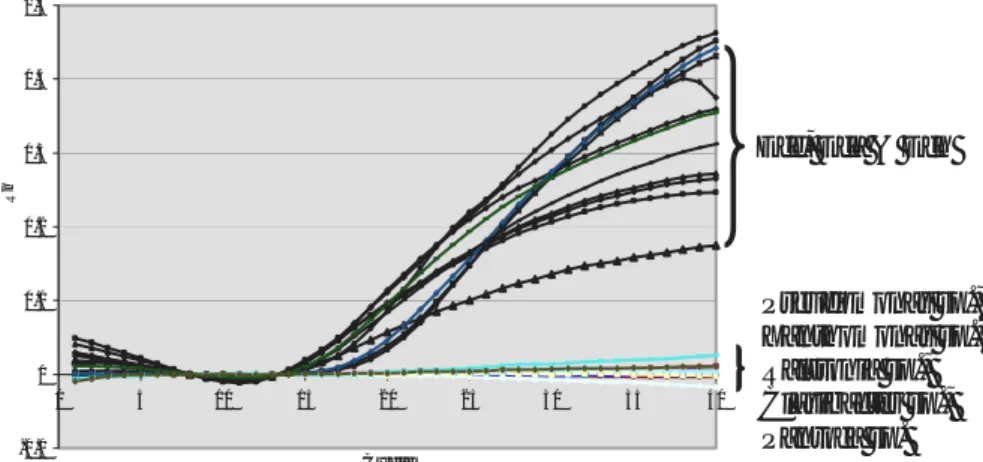Comm. Appl. Biol. Sci, Ghent University, 71/3b, 2006 1171
PRELIMINARY DEVELOPMENT OF REAL TIME PCR
FOR QUANTIFICATION OF
ERWINIA
SPECIES
INFECTING POTATO TUBERS
S. MASSART*, A. MOH*, S. ROUSSEL,
S. VAN MELLAERT & M.H. JIJAKLI
Plant Pathology Unit, Gembloux Agricultural University Passage des Déportés 2, BE-5030 Gembloux, Belgium
E-mail: jijakli.h@fsagx.ac.be
*The two first authors equally contributed to this work
INTRODUCTION
Erwinia carotovora subsp. atroseptica (Van Hall) (Eca), Erwinia carotovora subsp. carotovora (Dye) (Ecc), Erwinia chrysanthemi (Burkholder) (Ech) are pathogenic bacterias of potato crop, causing blackleg of stems in the field and soft rot of tubers in storage. During these last years, an outbreak of soft rot potatoes caused by the 3 Erwinia species has been observed in Belgium. Several methods are currently available for the detection of Erwinia sp. in potato tubers. These methods include plating on selective media, roting by the “Erwinia kit”, immunological methods and classical PCR tests. The pro-bability of black leg or soft rot development depends on the population level of Erwinia on potato tubers (Perombelon, 2002). So, the development of methods able to quantify the Erwinia population on tubers is required. Such quantification may be achieved by the use of real-time PCR. This technique combines the advantages of classical PCR (specificity, sensitivity, rapidity) with unique characteristics (lower limit of detection, no post-PCR step, easier quantification of the target). In this paper, we describe the first steps of the development of a real-time PCR method for the quantification of Erwinia population on potato tubers. To our knowledge, this is the first report of the development of a real-time PCR to detect Erwinia spp. on potato tubers.
MATERIAL AND METHOD
Sixteen Erwinia strains (5 Eca, 5 Ecc and 6 Ech ) were used in this work. Other strains belonging to 10 bacterial species, cited hereunder, were also tested. These micro-organisms were cultured on nutrient agar (NA) at 24° C during 48 or 72 hours. Genomic DNA (gDNA) was extracted using the Pure-gene extraction kit of Gentra system (Minneapolis, USA). The DNAMAN Soft-ware was used for sequence alignment. The primer pair SR3F-SR1cR and the corresponding PCR amplification conditions (Toth et al., 1999) were used. The Taq polymerase (Roche Applied Bioscience, Penzberg, Germany) and the qPCR Mastermix Plus (Eurogentec, Liège, Belgium) were used for classical and real-time PCR respectively. The sequencing reactions were made at GATC (Constance, Germany).
1172
RESULTS
PCR amplification and sequencing
The primer pairs amplified the expected 119 bp fragment from all the tested strains of Eca, Ecc and Ech.
Sequencing and probe design
Figure 1. Observation on agarose gel of the 119 bp DNA fragment amplified with the Eca (E. carotovora atroseptica), Ecc (E. carotovora carotovora) and Ech (E. chrysantemii) strains. M: DNA ladder 100 bp plus (Fermentas).
Figure 2. Real-time measurement of emitted fluorescence during amplification cycles with sample containing gDNA from various bacterial species.
1
1
1
1
9
9
b
b
p
p
M Eca Ecc Ech Blanc
Ecc, Eca & Ech
-0.1 0 0.1 0.2 0.3 0.4 0.5 0 5 10 15 20 25 30 35 40 Cycle Rn Pseudomonas sp., Xanthomonas sp., Ralstonia sp., Clavibacter sp., Pantoea sp.
Comm. Appl. Biol. Sci, Ghent University, 71/3b, 2006 1173
Two DNA fragments by subspecies (Figure 1) were cloned and sequenced. The six obtained sequences were aligned with 31 other sequences of Erwinia spp. from the public databases. A MGB-probe, polyvalent for all the pub-lished sequences of Eca, Ecc and Ech, was selected.
Polyvalence and specificity of the real-time PCR detection
The real-time PCR method succesfully detected the 16 Erwinia strains in our collection. Moreover, no fluorescence signal was observed for 10 other bacte-rial species (Ralstonia solanacearum, Clavibacter michiganensis michiganen-sis, Pseudomonas fluorescent, P. marginalimichiganen-sis, P. synrigae, Xanthomonas campestris, Pantoea agglomerans, Burkholderia cepacia, ...).
Detection on potato tuber
Ten tubers were randomly sampled in commercial potato lots. Among them, 8 presented a latent contamination of Erwinia spp. The actual limit of detec-tion of the method, calculated by adding known amounts of Erwinia cells to Erwinia-free potato tissue, corresponds to 1000 cells per ml of peel extract.
CONCLUSION
A real-time PCR protocol based on the primer pair SR3F-SR1cR and on a newly designed MGB-probe is under development. This protocol specifically detected our strains of Eca, Ecc and Ech. No fluorescence signal was ob-tained from other bacterial species commonly observed in potato tubers microflora. Furthermore, the limit of detection of the method (1000 cells/g of tuber or/ml of peel extract) was compatible with the thresholds proposed in the litterature for blackleg development (1000 cells/ml of peel extract) or for soft rot development (107 cells/g of tuber) (Perombelon, 2000 and 2002).
Ongoing research will be focused on the development and the validation of a quantitative real-time PCR protocol.
ACKNOWLEDGMENTS
This work was supported by the Federal Agency for the safety of the Food Chain (AF-SCA) and the General Management of Agriculture (DGA) of the Waloon Region Minis-tery (Belgium).
REFERENCES
PEROMBELON M. (2000). Blackleg risk potential of seed potatoes determined by quanti-fication of tuber contamination by the causal agent and Erwinia carotovora subsp. atroseptica: a critical review. EPPO Bulletin 30:413-420.
PEROMBELON M. (2002). Potato diseases caused by soft rot erwinias: an overview of pathogenesis. Plant Pathology 51:1-12,
TOTH I.K.,HYMAN L.J.&WOOD J.R. (1999). A one-step PCR-based method for the detec-tion of economically important soft rot Erwinia species on micropropagated potato plants. Journal of Applied Microbiology 87:158-166
